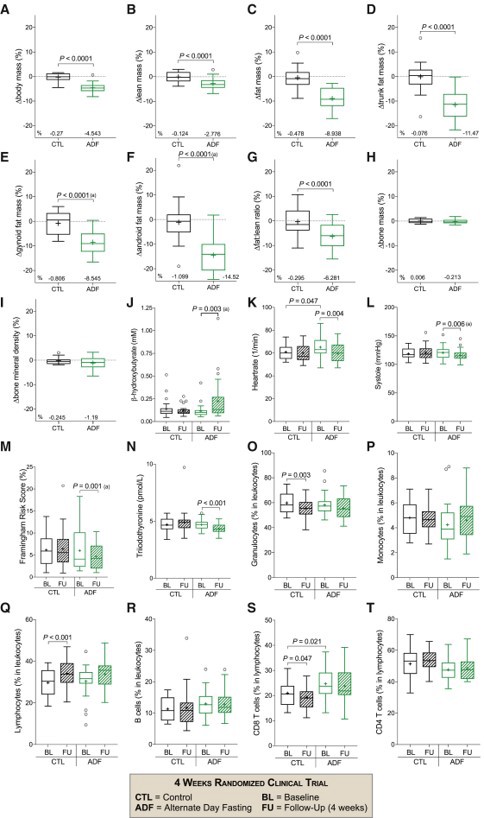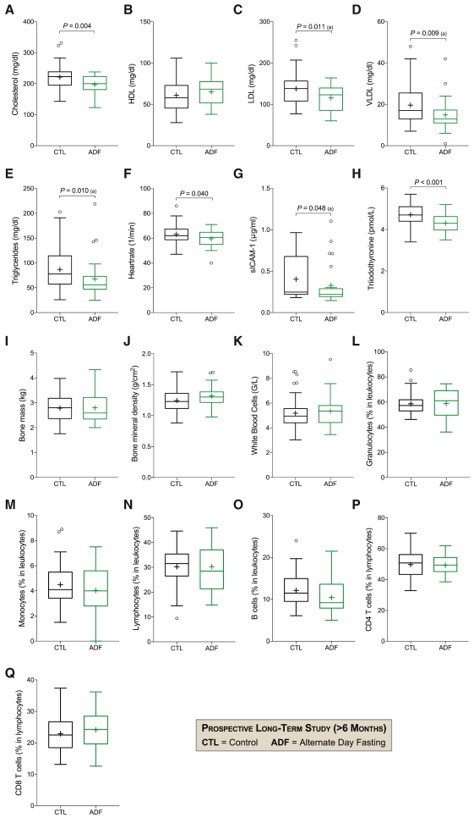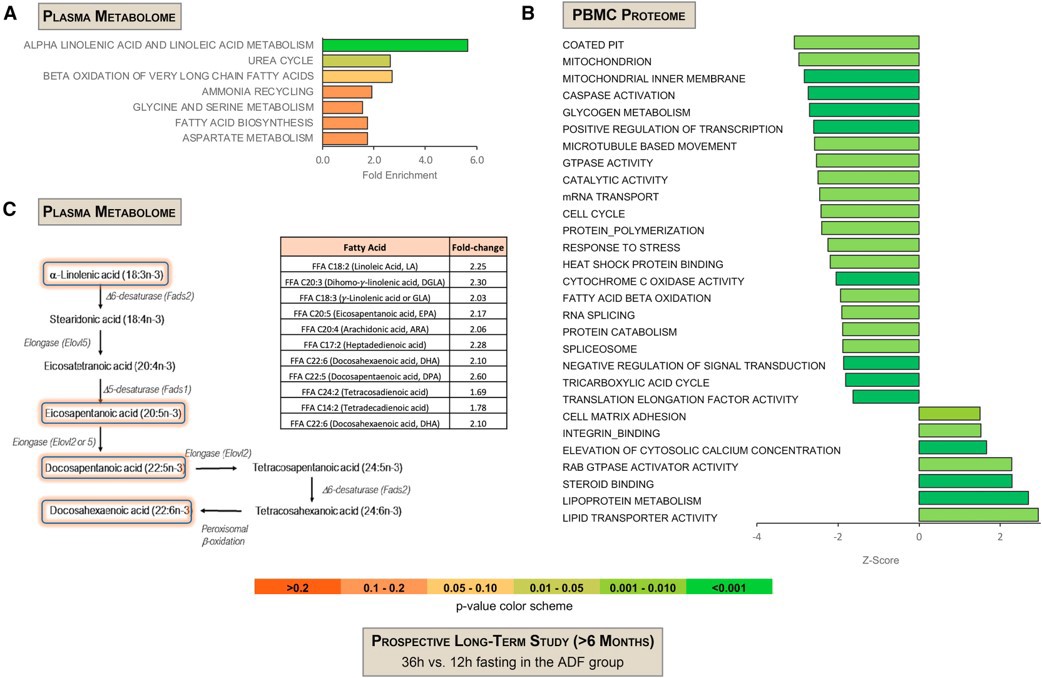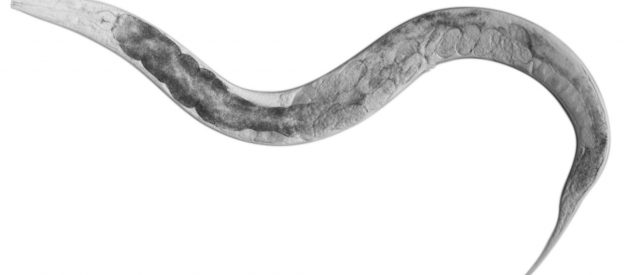
As if we needed another fasting study?
Fortunately, this one is a bit different than some of the more recent fasting studies on (early) time restricted feeding, or eTRF. In addition, it?s one of the few robust fasting studies that have been conducted on humans (not #inmice)? and healthy humans to that end.
Since I?ve written plenty about different fasting studies, the physiology of fasting, and why fasting is particularly good for health, I won?t provide a lengthy background here. Long story short ? fasting (or food restriction) prolongs lifespan and healthspan in model organisms like worms, flies, mice, and non-human primates. The effects of fasting are less studied in humans, for a few reasons.
For one, the interest in ?basic? mechanisms of fasting have led researchers to cut the calories of ?lower? species, who we can probe, dissect, and investigate down to the molecular level. To figure out why (and if) fasting works, we first study its effects in organisms like fruit flies before moving up to translational research in people like you and me.
Second of all, chronic calorie restriction (CR) is hard for most people, and scientists/health professionals believe that most CR regimens will prove to be unfeasible in the long term. Whether due to an incompatability with lifestyle or the uncomfortable hunger resulting from most CR regimens, drastically cutting calories-long term just sucks. Because of this, the topic has been infrequently implemented in the research field (with success).
As an alternative, intermittent fasting (IF) may actually be a manageable long-term solution ? a way to reduce calories (?accidentally?) and improve other health biomarkers in response to dietary energy reduction.?
In particular, alternate-day fasting (ADF) is a form of fasting that involves ?fast? ?feast? days; where no calories and ?unlimited? calories are consumed, respectively. Eat one day, fast the next, repeat. Sounds simple, and it is. It also might be feasible for more people and provide benefits above and beyond calorie-restriction.
Enjoying this story? Awesome readers like you are helping to support my work with a small donations through Venmo @Brady-Holmer, the Cash App $BradyHolmer or by becoming monthly supporters on Patreon! Everything helps, and I?m grateful for the support!
To date, most ADF (and fasting studies in general) have been done in overweight individuals or those with diseases like type 2 diabetes. Fasting is used as a ?curative? solution to a problem, and proves to be quite effective.
But what about the ?preventative? effects of fasting on aging and disease? Can fasting help the ?healthy? stave off the effects of physiological decline and ill health?
A new study investigates just that question.
 C. Elegans worm. The O.G. organism for fasting studies. Source: salk.edu
C. Elegans worm. The O.G. organism for fasting studies. Source: salk.edu
Published in ?Cell Metabolism?, the study, ?Alternate-day Fasting Improves Physiological and Molecular Markers of Aging in Healthy, Non-obese Humans? is the first randomized-control trial (RCT) to assess the effects of short-term ADF on a plethora of physiological, biochemical, cardiovascular, and anthropometric measures in a group of healthy adults.
What makes this study unique is that they also included a prospective study arm; recruiting a group of 30 ?regular fasters? who had been engaging in ADF for at least 6 months. So, in addition to the well-controlled experimental portion, we get some insight into the potential benefits (risks?) of long-term fasting by comparing these regular fasters to a non-fasting adult control group. A ?natural experiment?.
A total of 90 people participated; 30 in the prospective ?fasting? cohort, and another 60 who were randomized 1:1 into either the ADF (intervention) arm or a control arm (consumed their habitual diet) for a period of 4 weeks. Nobody in the ADF/control arm reported any previous fasting experience, everyone was ?normal weight?, and all of the groups had an average age between 48 and 52 years old.
Those assigned to the ADF group were told to eat every other day. On these ?fasting days?, no calorie-containing foods or beverages would be consumed, and even diet soda was prohibited. What was allowed? Water, flavored carbonated water, unsweetened black/green tea, and black coffee.
The non-fasting days, colloquially termed ?feast days? provided zero restrictions on the amount or type of food consumed; this is termed ad libitum eating.
The outcomes of this study were pretty comprehensive, so we?ll talk about only some of the more relevant ones here. In terms of anthropometrics, outcomes included body weight, bone density, lean mass, fat mass, bone mass, bone mineral density, and total body composition.
Biochemical analysis of blood samples included assessments for insulin, c-peptide, testosterone, cortisol, thyroid hormones, estrogen, sex-hormone binding globulin, vitamin D, appetite hormones (ghrelin, leptin, peptide YY), free fatty acids, and oxidative stress biomarkers. Many of these are involved in aging, cardiovascular disease, hormone health, and metabolic health.
A suite of cardiovascular-related measures was performed; including blood pressure, heart rate, and pulse-wave velocity ? a measure of the stiffness of one?s arteries and a potent predictor of long-term cardiovascular health.
A final interesting outcome measure was related to ketosis. Serum levels of beta-hydroxybutyrate ? a ketone body produced in the liver from the breakdown of fat ? was measured in all groups. BHB, in addition to its role in ketosis, has several signaling roles involved in aging and metabolic regulation.
Enough with the measures, let?s get to the results.
Enjoy this post? Sign up for my email newsletter, which I send out each Friday, where I discuss a study I found interesting each week.
Short Term Effects of ADF
Perhaps the first variable to consider in this study is whether or not the participants were actually compliant with the protocol ? did they alternate-day fast? Indeed they did, and then some.
In terms of caloric restriction (measured using food-frequency questionnaires to estimate caloric intake), the ADF group reduced their weekly caloric consumption by about 37%.
This is quite an impressive reduction compared to other human studies that haven?t even managed to reach 25% CR. This also means that participants were unable to ?compensate? on ?feast days? for the food they didn?t consume on the fast days. Given that it would require eating double your normal intake, the finding makes sense.
Interestingly, the control group reduced their caloric intake also ? a mere 8% ? but nevertheless still a reduction.
 ADF reduces body weight (A), lean (B), and fat mass, and fat:lean ratios (G). Most fat loss observed in the android area. No influence on bone mass (H) or bone mineral density (I). Serum levels of ?-hydroxybutyrate were elevated in the ADF group after 4 weeks (J) and a reduced risk for CVD was measured by means of the reduced heartrate (K), systolic blood pressure (L), and Framingham Risk Score (M).
ADF reduces body weight (A), lean (B), and fat mass, and fat:lean ratios (G). Most fat loss observed in the android area. No influence on bone mass (H) or bone mineral density (I). Serum levels of ?-hydroxybutyrate were elevated in the ADF group after 4 weeks (J) and a reduced risk for CVD was measured by means of the reduced heartrate (K), systolic blood pressure (L), and Framingham Risk Score (M).
Body composition responded favorably to the intervention. ADF led to a significant reduction in BMI and fat mass. More importantly, the fat mass loss came primarily from the trunk region of the body (termed android fat), which is considered to be the most ?toxic? or detrimental type of fat. ADF also improved the lean mass to fat mass ratio (i.e. lower body fat %). Bone mass wasn?t affected, while a marginal decline in bone mineral density was observed.
Cardiovascular health improved quite impressively. After just 4 weeks, systolic, diastolic, and mean arterial pressure all dropped by 6 mmHg, 2mmHg, and 2mmHG, respectively. Along with blood pressure, arterial stiffness assessed as pulse-wave velocity (PWV) was reduced by about 0.2 m/s ? signifying less-stiff arteries. To put this in perspective, a few weeks of exercise training can lower PWV by around the same amount.
The improvement in all of these cardiovascular measures led to a significant reduction in something called the ?Framingham Risk Score? (FRS). This composite measure of CVD risk factors is used to estimate an individual?s risk for developing CVD within the next 10 years. In this study, FRS scores were reduced in the ADF group by a significant 1.4%.
Finally, short-term ADF reduced a hormone called triiodothyronine or fT3. fT3 is one of the thyroid hormones and, in the absence of impaired thyroid gland function, lower levels are linked to increased lifespan in humans. Other than fT3, other aging-related parameters like blood lipids and immune cells remained unchanged by 4 weeks ADF.
Is it keto? Yup. Blood samples taken from the ADF group showed that blood levels of the ketone body BHB were high after 4 weeks of ADF? even on the non-fasting day when blood was taken.
Long Term Effects of ADF
These results were acquired by comparing baseline status of long term ?regular fasters? to healthy non-fasting controls.
Overall, the long-term ADF group reported a lower caloric intake than the control group: eating about 8700 calories/week compared to 12,300 ? a 28% difference. Michael Phelps was once reported to consume over 10000 calories in a day ? just for some perspective.
Compared to the non-fasting group, those who had done ADF for >6 months had lower levels of total cholesterol, low-density lipoprotein (LDL), very low-density lipoprotein (vLDL), and triglycerides. High-density lipoprotein (HDL) was similar in both groups, and the ADF group had a lower resting heart rate.
Interesting digression ? a lower resting heart rate is actually linked to longevity.
 ADF is associated with lower levels of total cholesterol (A), LDL , VLDL (D) and triglycerides (E), while HDL levels (B) remain comparable to the control group. The heart rate (F), the inflammation marker sICAM-1 (G) and the circulating levels of triiodothyronine (H) are lower in the >6 months of ADF group. The total bone mass (I), bone mineral density (J) and white blood cell count (K) are comparable to controls.
ADF is associated with lower levels of total cholesterol (A), LDL , VLDL (D) and triglycerides (E), while HDL levels (B) remain comparable to the control group. The heart rate (F), the inflammation marker sICAM-1 (G) and the circulating levels of triiodothyronine (H) are lower in the >6 months of ADF group. The total bone mass (I), bone mineral density (J) and white blood cell count (K) are comparable to controls.
Some non-significant differences between groups illustrate that ADF may not be detrimental to long-term health. Bone mass, bone mineral density, white blood cell counts, and other immune-related measures were the same between fasting and non-fasting groups. No iron deficiency was noted in the ADF group either. Consistent with findings of the short-term ADF, the long-term fasting group had lower circulating fT3 and normal thyroid function.
The ADF group also differed to the control group in one important biomarker known as soluble intracellular adhesion molecule (sICAM-1). This pro-inflammatory cytokine is implicated in aging and other diseases. Reduced levels suggest a benefit the health and longevity, and those who fasted regularly had lower levels.
Fasting and Feasting
One conundrum in studies involving fasting is that it?s sometimes impossible to isolate the effects of fasting from those of calorie restriction. Since simply lowering calories in the diet in the absence of fasting leads to beneficial health effects, we can?t really say if fasting-related health improvements were due to fasting per se . Maybe it was just the reduction in calories.
In an attempt to tweeze out what happens differently (at the molecular level) when fasting or feasting, the researchers analyzed a boatload of proteomic and metabolic genes, hoping to gain some insight into how gene expression ?cycles? along with nutrient availability and what specific cell pathways are activated/inactivated when we fast.
After 36 hours of fasting, some 54 metabolic genes were increased by at least 20% ? including genes related to lipids and antioxidants like vitamin E. Another 49 genes were 20% lower ? some of which were related to amino acids like methionine ? which has been shown to play a role in lifespan.
 Variations between 36 hour and 12 hour fast during ADF show a pattern of periodic lipid enrichment and amino acids depletion in humans.
Variations between 36 hour and 12 hour fast during ADF show a pattern of periodic lipid enrichment and amino acids depletion in humans.
In addition, pathways that are related to the essential fatty acids omega-3 and omega-6 were upregulated along with those involved in the metabolism of fatty acids.
Changes to the proteome suggested a similar adaptation ? genes related to lipid metabolism, mitochondrial fat metabolism, glycogen metabolism, and the ATP-producing TCA cycle were all increased.
Stress-response pathways including the heat-shock proteins and autophagy regulators were increased following fasting as well. These data support what the mechanistic literature has been demonstrating in lower-level organisms. Pretty neat stuff.
We now have some evidence that fasting (ADF, at least) for as little as 4 weeks can lead to considerable positive changes in cardiovascular and metabolic health in already healthy adults (healthy in that they were disease-free).
Maybe the results were due to the 37% calorie restriction achieved by ADF, and not some special effect of fasting itself. I highly doubt this. But, even if it were just a result of reduced food intake, this demonstrates that ADF is a great way to reduce total food consumption! Compared to miserable diets, unbearable hunger, or slim-fast shakes, ADF seems pretty feasible.
Should you fast? This question doesn?t have a ?yes? or ?no? answer, but increasingly, the evidence in mounting in favor of the fact that periodically reducing food intake is beneficial for our health. It?s an eating pattern that is far-removed from our modern day practice of constant energy intake. But, it?s an eating pattern that likely aligns with our evolutionary and circadian biology.
Fasting (in this study and others) increases ketone bodies (BHB) in the blood. BHB has been shown to improve longevity, healthspan, metabolic health, and cognitive function, even prevent epileptic seizures. It?s the reason the ketogenic diet is such as potent health intervention for many people.
While this study involved a ?strict? ADF regimen that completely removed caloric intake on fast days, similar protocols may not be as extreme. ADF Regimens involving eating 25% of your normal intake on fast days can also be undertaken, and show similar benefits. You can also do TRF, eTRF, IF, or any of the other fasting acronyms that we just can?t seem to get enough of.
While this study was only 4 weeks long, and hardly represents the feasibility of experimental ADF for longer periods of time (say, years), it nonetheless indicates that people could stick to this eating regimen or something similar to it. Hopefully some longer-term studies come out of this one.
I?ll end by rephrasing a famous Michael Pollan quote:
?Eat food (infrequently),
Mostly plants (but sometimes nothing),
Not too much (and sometimes nothing at all).

References
Slaven Stekovic, Sebastian J. Hofer, Norbert Tripolt, Miguel A. Aon, et al. Alternate Day Fasting Improves Physiological and Molecular Markers of Aging in Healthy, Non-obese Humans, Cell Metabolism, 2019,ISSN 1550?4131,


